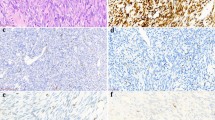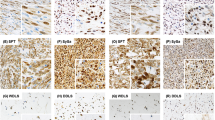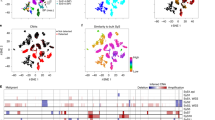Abstract
A recent large multi-centre study convincingly confirmed previous observations that the SYT-SSX1 fusion type, compared to SYT-SSX2, of synovial sarcoma is associated with a worse clinical outcome. Apart from the clinical impact, this fact also suggests (1) that the SYT-SSX fusion gene may influence molecular mechanisms involved in tumour growth and progression; and (2) that the SYT-SSX1 fusion type has a stronger influence on these mechanisms than SYT-SSX2. The nature of the underlying mechanisms is, however, still unknown. In this study we made use of the SYT-SSX1 vs SYT-SSX2 concept to investigate whether major, tumour relevant, and growth regulatory proteins (e.g. cyclins and cyclin-dependent kinases) may be involved. Using Western blotting analysis on 74 fresh, fusion variant-typed, tumour samples from localized synovial sarcoma, we found a significant correlation between SYT-SSX1 and high expression of cyclin A (P=0.003) and D1 (P=0.025). Our data suggest that SYT-SSX may influence the cell cycle machinery, and that the more aggressive phenotype of the SYT-SSX1 variant is due to an accelerated tumour cell proliferation.
This is a preview of subscription content, access via your institution
Access options
Subscribe to this journal
Receive 50 print issues and online access
$259.00 per year
only $5.18 per issue
Buy this article
- Purchase on Springer Link
- Instant access to full article PDF
Prices may be subject to local taxes which are calculated during checkout



Similar content being viewed by others
References
Adams JM, Cory S . 1998 Science 281: 1322–1326
Bukholm IR, Bukholm G, Nesland JM . 2001 Int. J. Cancer 93: 283–287
Clark J, Rocques PJ, Crew AJ, Gill S, Shipley J, Chan AM, Gusterson BA, Cooper CS . 1994 Nat. Genet. 7: 502–508
de Leeuw B, Baltmans M, Olde Weghuis D, Geurts van Kessel A . 1995 Hum. Mol. Genet. 4: 1097–1099
dos Santos NR, de Bruijn DR, van Kessel AG . 2001 Genes Chromos. Cancer 30: 1–14
Evan GI, Vousden KH . 2001 Nature 411: 342–348
Handa K, Yamakawa M, Takeda H, Kimura S, Takahashi T . 1999 Int. J. Cancer 84: 225–233
Hunter T, Pines J . 1994 Cell 79: 573–582
Huuhtanen RL, Blomqvist CP, Bohling TO, Wiklund TA, Tukiainen EJ, Virolainen M, Tribukait B, Andersson LC . 1999 Cancer Res. 59: 2885–2990
Inagaki H, Nagasaka T, Otsuka T, Sugiura E, Nakashima N, Eimoto T . 2000 Mod. Pathol. 13: 482–488
Kawai A, Woodruff J, Healey JH, Brennan MF, Antonescu CR, Ladanyi M . 1998 N. Engl. J. Med. 338: 153–160
Kim SH, Lewis JJ, Brennan MF, Woodruff JM, Dudas M, Cordon-Cardo C . 1998 Clin. Cancer Res. 4: 2377–2382
Ladanyi M . 2001 Oncogene 20: 5755–5762
Ladanyi M, Antonescu CR, Leung DH, Woodruff JM, Kawai A, Healey JH, Brennan MF, Bridge JA, Neff JR, Barr FG, Goldsmith JD, Brooks JS, Goldblum JR, Ali SZ, Shipley J, Cooper CS, Fisher C, Skytting B, Larsson O . 2002 Cancer Res. 62: 135–140
Mancuso T, Mezzelani A, Riva C, Fabbri A, Dal Bo L, Sampietro G, Perego P, Casali P, Zunino F, Sozzi G, Pierotti MA, Pilotti S . 2000 Lab. Invest. 80: 805–813
Mishina T, Dosaka-Akita H, Hommura F, Nishi M, Kojima T, Ogura S, Shimizu M, Katoh H, Kawakami Y . 2000 Clin. Cancer Res. 6: 11–16
Nielsen NH, Arnerlov C, Emdin SO, Landberg G . 1996 Br. J. Cancer 74: 874–880
Nilsson G, Skytting B, Xie Y, Brodin B, Perfekt R, Mandahl N, Lundeberg J, Uhlen M, Larsson O . 1999 Cancer Res. 59: 3180–3184
Quelle DE, Ashmun RA, Shurtleff SA, Kato JY, Bar-Sagi D, Roussel MF, Sherr CJ . 1993 Genes Dev. 7: 1559–1571
Shamma A, Doki Y, Shiozaki H, Tsujinaka T, Inoue M, Yano M, Kimura Y, Yamamoto M, Monden M . 1998 Int. J. Oncol. 13: 455–460
Sherr CJ . 1995 Trends Biochem. Sci. 20: 187–190
Sherr CJ . 1996 Science 274: 1672–1677
Sherr CJ . 2000 Cancer Res. 60: 3689–3695
Skytting B, Nilsson G, Brodin B, Xie Y, Lundeberg J, Uhlen M, Larsson O . 1999 J. Natl. Cancer Inst. 91: 974–975
Thaete C, Brett D, Monaghan P, Whitehouse S, Rennie G, Rayner E, Cooper CS, Goodwin G . 1999 Hum. Mol. Genet. 8: 585–591
Turc-Carel C, Dal Cin P, Limon J, Rao U, Li FP, Corson JM, Zimmerman R, Parry DM, Cowan JM, Sandberg AA . 1987 Proc. Natl. Acad. Sci. USA 84: 1981–1985
Xie Y, Skytting B, Nilsson G, Gasbarri A, Haslam K, Bartolazzi A, Brodin B, Mandahl N, Larsson O . 2002 Cancer Res. 62: (in press)
Acknowledgements
This project was supported by grants from the Swedish Cancer Society, the Cancer Society in Stockholm, the Swedish Children Cancer Society and the Karolinska Institute.
Author information
Authors and Affiliations
Corresponding author
Rights and permissions
About this article
Cite this article
Xie, Y., Skytting, B., Nilsson, G. et al. The SYT-SSX1 fusion type of synovial sarcoma is associated with increased expression of cyclin A and D1. A link between t(X;18)(p11.2; q11.2) and the cell cycle machinery. Oncogene 21, 5791–5796 (2002). https://doi.org/10.1038/sj.onc.1205700
Received:
Revised:
Accepted:
Published:
Issue Date:
DOI: https://doi.org/10.1038/sj.onc.1205700
Keywords
This article is cited by
-
The Biology of Synovial Sarcoma: State-of-the-Art and Future Perspectives
Current Treatment Options in Oncology (2021)
-
Synovial Sarcoma: A Complex Disease with Multifaceted Signaling and Epigenetic Landscapes
Current Oncology Reports (2020)
-
Loss of Par3 promotes prostatic tumorigenesis by enhancing cell growth and changing cell division modes
Oncogene (2019)
-
The Effect of SYT-SSX and Extracellular Signal-Regulated Kinase (ERK) on Cell Proliferation in Synovial Sarcoma
Pathology & Oncology Research (2011)
-
Chromosomal and genetic imbalances in synovial sarcoma detected by conventional and microarray comparative genomic hybridization
Journal of Cancer Research and Clinical Oncology (2006)



